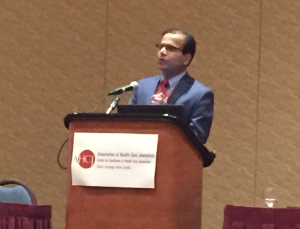ORLANDO – Stress affects one in five Americans, sending many people to a therapist’s office to address the problem.
But what if people could prevent stress on their own?
That was the focus of the “Science of Stress” session at the Association of Healthcare Journalists conference on April 20, 2017 led by Dr. Amit Sood.
Sood, a professor of medicine at the Mayo Clinic College of Medicine, led the room full of journalists through his four-step guide to happiness, which is explained in more detail in his book.

Dr. Amit Sood talks at AHCJ 2017 in Orlando, FL. His session focused on the science behind stress, and ways to prevent it. Photo by Daniel Levitt
Step One – Gratitude
Have you ever woken up and the first thing that enters your mind is the thing you fell asleep thinking about the night before? You’re not alone. Humans wake up with adrenaline and steroids racing through their minds caused by worrying about money, for example, or work. Sood calls this “recency bias.”
This first step is all about reversing that habit. Sood advises not leaving bed until you’ve thought of five people who are a big part in your life and who care about you.
“This is a short practice that I do everyday in the morning, and this is what we call ‘morning gratitude’,” Sood said.
This forces the brain to minimize the adrenaline and steroids and replace them endorphins, which pass along positive signals to other parts of the body, he said.
Step Two – Mindful Presence
Sood said that this next step involves the “two-minute rule:” spending at least two minutes with your family or friends at the end of each day.
The trick is to treat them as if you hadn’t seen them for 30 days.
Before going into his house after work each day, Sood tells himself, “’I will meet some very special people who I have not seen for a month,’” Sood said. “Every day has been better for the last six years I’ve been doing it.”
Sood added that people should point out something their friend or family member did well. This will evoke with endorphins, not adrenaline.
Step Three – Kindness
The next step focuses on the mindset that all people are special in their own way and have their own problems. With this awareness, you can either judge people on your first impression of them and then expect to be judged in the same way. Or you can send them a silent “I wish you well” to recognize that they are special.
“When you wishing somebody well, you are wishing two people well,” Sood said. “One person is the person you’re wishing well… and the other is yourself.”
Step Four – Resilience
The last step focuses on two sides to the brain that operates in different ways: the reactive side and the rational side.
The former is the side of the brain that is fearful and thus thinks short-term. The latter is the part of the brain that is driven by meaning and therefore thinks long-term.
Sood said that people should focus on activating “Mr. Rational,” as he called it, which will again help in eliminating adrenaline and steroids in the brain and instead create endorphins.
Advertisements Share this:




